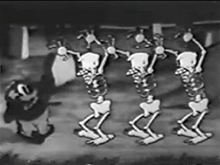Hittin' the Trail for Hallelujah Land
| Hittin' the Trail for Hallelujah Land | |
|---|---|
| Merrie Melodies (Piggy) series | |
 Uncle Tom is terrorized by skeletons in a scene reminiscent of Walt Disney's 1929 film The Skeleton Dance. | |
| Directed by | Rudolf Ising |
| Produced by | Leon Schlesinger |
| Music by | Frank Marsales |
| Animation by |
Isadore Freleng Paul Smith |
| Studio | Warner Bros. Pictures |
| Distributed by |
Warner Bros. The Vitaphone Corporation |
| Release date(s) | November 28, 1931 (USA) |
| Color process | Black and white |
| Running time | 7 min (one reel) |
| Language | English |
| Preceded by | You Don't Know What You're Doin'! (1931) |
| Followed by | Red-Headed Baby (1931) |
Hittin' the Trail for Hallelujah Land is a Merrie Melodies animated cartoon directed by Rudy Ising (uncredited), produced by Leon Schlesinger Productions, Warner Bros. Pictures and The Vitaphone Corporation, and released to theatres on November 28, 1931. The minimal storyline centers on the plucky Piggy's efforts to rescue his girlfriend and a doglike Uncle Tom from perilous predicaments and villains. The short's stereotypical portrayal of black characters prompted United Artists to withhold it from syndication in 1968, making it one of the infamous Censored Eleven.
Summary


Hittin' the Trail for Hallelujah Land has a rudimentary plot, unlike most of the Merrie Melodies of the time, which barely have any plot at all.[1] The cartoon stars the Mickey Mouse-esque Piggy, his girlfriend Fluffy, and a canine Uncle Tom.[2] The film opens with a singing steamboat dancing down a river. On the deck, three blackface caricatures play the song for which the short is named on the harmonica, banjo, and bones. Meanwhile, Uncle Tom drives Fluffy toward the boat by donkey cart. The scene shifts to Piggy the riverboat captain in a sequence reminiscent of Disney's 1928 film Steamboat Willie.[2]
Fluffy joins the frolicking steamboat passengers and reunites with her boyfriend, but during the revelry, Piggy falls overboard. The pig has a run in with an alligator, but he makes it back to the boat. Meanwhile, Uncle Tom's donkey bucks him into a cemetery. There, in a variation on a stock gag featuring a superstitious black man,[3] he is scared by three dancing skeletons reminiscent of those in Disney's 1929 short The Skeleton Dance. Tom escapes to the middle of the river, but a shoddy boat leaves him stranded and drowning. Piggy saves the day but not before a vaudevillian villain kidnaps his porcine paramour. Piggy captures the villain on a passing mail hook, leaving the villain tortured over a buzz saw. This short marks the second and last appearance of the characters Piggy and Fluffy.[2]
Credits
- Produced by Leon Schlesinger
- Directed by Rudolf Ising (uncredited)
- Drawn by Isadore Freleng and Paul Smith
- Musical score by Frank Marsales
Distribution
Hittin' the Trail for Hallelujah Land was released in American theaters on November 28, 1931 by Warner Bros. The cartoon's copyright expired in 1959, making it go into public domain. However, the cartoon has been withheld from distribution since 1968. At that time, United Artists owned the rights to most Looney Tunes and Merrie Melodies cartoons. Hittin' the Trail for Hallelujah land and ten other cartoons were deemed to feature racist depictions of African Americans that were too integral to the films for simple cuts to make them palatable for modern audiences.[4] The cartoon has never been released on laserdisc, home video, or DVD, not counting public domain home releases. These eleven cartoons make up the so-called Censored Eleven.[2]
See also
References
- ↑ BBeck, Jerry, and Will Friedwald (1989). Looney Tunes and Merrie Melodies: A Complete Illustrated Guide to the Warner Bros. Cartoons. Owl Books. ISBN 0-8050-0894-2. Page 12.
- 1 2 3 4 Cruz, Brian (2003). "Hittin' the Trail for Hallelujah Land". Looney Tunes and Merrie Melodies: The Early Years. Toon Zone. Accessed 21 June 2007.
- ↑ Lindvall, Terry, and Ben Fraser (1998). "Darker Shades of Animation: African-American Images in Warner Bros. Cartoons". Reading the Rabbit: Explorations in Warner Bros. Animation. Rutgers University Press. page 128.
- ↑ Did Bugs Bunny appear in a racist cartoon during World War II?, The Straight Dope, February 5, 2002
External links
- Hittin' the Trail for Hallelujah Land at the Internet Movie Database
- Hittin' the Trail for Hallelujah Land at the Big Cartoon Database
- Hittin' the Trail for Hallelujah Land is available for free download at the Internet Archive
- Hittin' the Trail for Hallelujah Land on YouTube